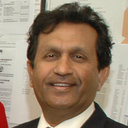Localization of human herpesvirus type 8 in human sperms by in situ PCR.
Keywords
Abstract
OBJECTIVE
Defining the mechanism of infection with human herpesvirus-8 (HHV-8) or Kaposi's sarcoma associated herpesvirus (KSHV) is an important clinical issue. HHV-8 has been linked to Kaposi's sarcoma (KS) development in HIV-1-infected individuals, and KS develops in 40% of those infected with both viruses. A series of epidemiological data suggest that sexual transmission is one of the routes of transmission for HHV-8. In our studies, we sought to assess the cellular reservoirs of HHV-8 DNA in the semen of HIV-1-infected men and the potential role of HHV-8 infected spermatozoa in horizontal transmission.
METHODS
A nested polymerase chain reaction (PCR), in situ PCR (ISPCR) and a sodium iodide (NaI) DNA isolation technique that extracts both nuclear and episomal DNA were utilized to amplify specific genes in vitro and within intact cells to evaluate the types of seminal cells infected with HHV-8 in HIV-1-infected and uninfected men.
RESULTS
HHV-8 was present in the spermatozoa and mononuclear cells of the semen in 64 of 73 (88%) HIV-1 infected individuals. Both the sperms as well as the mononuclear cells of the semen specimens of HIV-1 infected men were found to be infected with HHV-8. Multiplex ISPCR revealed that a significantly higher percentage of semen cells were infected with HHV-8 than HIV-1 (p>0.001). Rare (less than one in a 100,000) sperm cells were co-infected with both viruses. A co-culture of HHV-8 infected sperm with uninfected 293 or Sup-T1 cell lines resulted in an abortive infection of these cells with HHV-8. DNA isolation by NaI yielded 73% of the positive sperm, whereas the standard phenol/chloroform method resulted in significantly lower positives (45%) from the same specimens.
CONCLUSIONS
Design and methods: Our data strongly suggest a potential sexual/horizontal route of transmission of HHV-8, via the HHV-8 infected sperm and other semen cells, where a large percentage of HIV-1 infected men's sperm and other semen cells are infected with HHV-8. Co-culture studies have further supported the observations that HHV-8 in the sperm cells is infectious and capable of transmission of the virus to uninfected cells.


